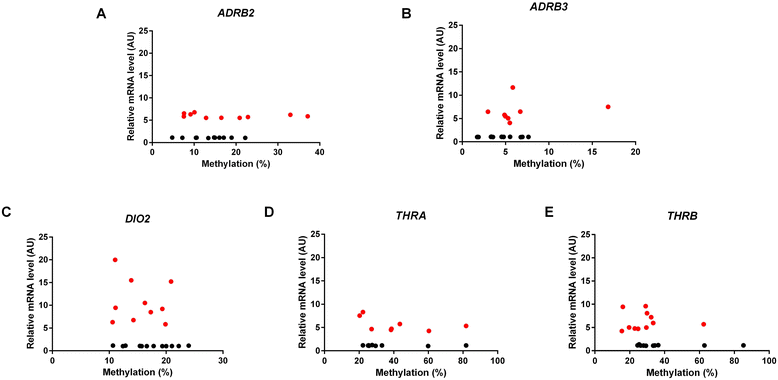Obesity is associated with a decrease in expression but not with the hypermethylation of thermogenesis-related genes in adipose tissues
- PMID: 25622596
- PMCID: PMC4314800
- DOI: 10.1186/s12967-015-0395-2
Obesity is associated with a decrease in expression but not with the hypermethylation of thermogenesis-related genes in adipose tissues
Abstract
Background: Impaired thermogenesis can promote obesity. Therefore, the aim of this study was to investigate whether the expression of thermogenesis-related genes is altered in adipose tissues of obese individuals and whether excessive methylation of their promoters is involved in this phenomenon.
Methods: The expression of genes encoding β adrenergic receptors (ADRBs), thyroid hormone receptors (THRs), 5'-iodothyronine deiodinases (DIOs), and uncoupling proteins (UCPs) was measured by real-time PCR in visceral and in subcutaneous adipose tissues of 58 obese (BMI >40 kg/m(2)) and 50 slim (BMI 20-24.9 kg/m(2)) individuals. The methylation status of these genes was studied by the methylation-sensitive digestion/real-time PCR method.
Results: The expression of ADRB2, ADRB3, THRA, THRB, DIO2, UCP2 was significantly lower in the adipose tissues of obese patients than in tissues of normal-weight individuals (P < 0.00001). In the obese, the expression of ADRB2, ADRB3, DIO2 was lower in visceral adipose tissue than in subcutaneous adipose tissue (P = 0.008, P = 0.002, P = 0.001, respectively). However, the mean methylation of CpG islands of these genes was similar in tissues with their high and low expression, and there was no correlation between the level of expression and the level of methylation.
Conclusions: Decreased expression of thermogenesis-related genes in adipose tissues of obese patients might result in the reduced reactivity to both hormonal and adrenergic stimuli and therefore in a lower potential to activate thermogenesis.
Figures




Similar articles
-
SIRT1 and SIRT7 expression in adipose tissues of obese and normal-weight individuals is regulated by microRNAs but not by methylation status.Int J Obes (Lond). 2016 Nov;40(11):1635-1642. doi: 10.1038/ijo.2016.131. Epub 2016 Aug 2. Int J Obes (Lond). 2016. PMID: 27480132
-
Sex-dependent dietary obesity, induction of UCPs, and leptin expression in rat adipose tissues.Obes Res. 2001 Sep;9(9):579-88. doi: 10.1038/oby.2001.75. Obes Res. 2001. PMID: 11557839
-
Brown adipose tissue genes in pericardial adipose tissue of newborn sheep are downregulated by maternal nutrient restriction in late gestation.Pediatr Res. 2013 Sep;74(3):246-51. doi: 10.1038/pr.2013.107. Epub 2013 Jun 20. Pediatr Res. 2013. PMID: 23788058
-
Brown adipose tissue, thermogenesis, angiogenesis: pathophysiological aspects.Horm Mol Biol Clin Investig. 2014 Jul;19(1):5-11. doi: 10.1515/hmbci-2014-0014. Horm Mol Biol Clin Investig. 2014. PMID: 25390012 Review.
-
Thyroid hormone and adipocyte differentiation.Thyroid. 2008 Feb;18(2):185-95. doi: 10.1089/thy.2007.0254. Thyroid. 2008. PMID: 18279019 Review.
Cited by
-
Original Research: Hydroxytyrosol, an ingredient of olive oil, reduces triglyceride accumulation and promotes lipolysis in human primary visceral adipocytes during differentiation.Exp Biol Med (Maywood). 2016 Oct;241(16):1796-802. doi: 10.1177/1535370216654226. Epub 2016 Jun 10. Exp Biol Med (Maywood). 2016. PMID: 27287014 Free PMC article.
-
Different Effects of Obesity and Fasting on the Expression of Type 3 Deiodinase and Thyroid Hormone Receptors in the Liver and Visceral Adipose Tissue of C57BL/6 Male Mice.Indian J Endocrinol Metab. 2024 May-Jun;28(3):320-326. doi: 10.4103/ijem.ijem_400_23. Epub 2024 Jun 26. Indian J Endocrinol Metab. 2024. PMID: 39086565 Free PMC article.
-
Prediction and Identification of Power Performance Using Polygenic Models of Three Single-Nucleotide Polymorphisms in Chinese Elite Athletes.Front Genet. 2021 Oct 8;12:726552. doi: 10.3389/fgene.2021.726552. eCollection 2021. Front Genet. 2021. PMID: 34691150 Free PMC article.
-
Brown Seaweed Food Supplementation: Effects on Allergy and Inflammation and Its Consequences.Nutrients. 2021 Jul 29;13(8):2613. doi: 10.3390/nu13082613. Nutrients. 2021. PMID: 34444774 Free PMC article.
-
Insights into the molecular and genetic role of obesity in breast cancer pathogenesis.Cancer Biol Ther. 2025 Dec;26(1):2501345. doi: 10.1080/15384047.2025.2501345. Epub 2025 May 12. Cancer Biol Ther. 2025. PMID: 40353441 Free PMC article. Review.
References
-
- Aronne LJ, Wadden T, Isoldi KK, Woodworth KA. When prevention fails: obesity treatment strategies. Am J Med. 2009;122(4 Suppl 1):S24–32. - PubMed
Publication types
MeSH terms
Substances
LinkOut - more resources
Full Text Sources
Other Literature Sources
Medical
Research Materials

